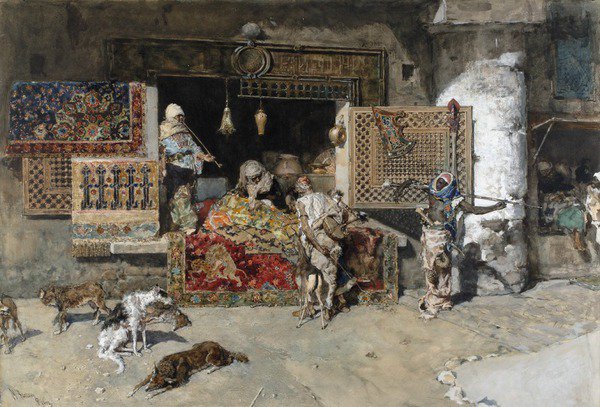Mariano Fortuny
dal 13/4/2015 al 12/7/2015
Segnalato da
13/4/2015
Mariano Fortuny
Museo de Bellas Artes, Bilbao
The Museum is showing one of the best of his late paintings, a watercolour entitled The Carpet Seller, dating from 1870. Theme (generally run-of-the-mill) is not the decisive factor in his painting; what counts is the masterly use of colour and light.

Mariano Fortuny (Reus, Tarragona, 1838-Rome, 1874) was one of the finest painters in 19th-century Spanish art. Apart from his central role in the painting of his time, his close friendship with Bilbao painter Eduardo Zamacois (Bilbao, 1841-Madrid, 1871) adds interest to the latest edition (number 49) of the Guest Work programme. In 2006 a late work of his, Beach at Portici, was part of the programme and shortly afterwards, in 2007, an exhibition organised by the Museum Zamacois-Fortuny-Meissonier showed, together with works by his friend Zamacois and the latter's maestro, Meissonier, ten or so of Fortuny's finest works. On this occasion, the Museum is showing one of the best of his late paintings, a watercolour entitled The Carpet Seller, dating from 1870.
Although Zamacois was a friend of Spanish painters Raimundo de Madrazo, Eduardo Rosales and Martín Rico, he was particularly close to Mariano Fortuny. Zamacois helped Fortuny to establish himself in art circles and in the hard-to-crack Paris art market. The two painters struck up a close, lasting personal and professional relationship. Indeed, the most famous portrait of Zamacois, an etching from 1869 now in the Museum, is by Fortuny. The two got to know each other in autumn 1866. Zamacois offered Fortuny the use of his Paris studio as a place to show the works he had recently brought from Rome. Most of the Spanish colony of artists were decidedly impressed by Fortuny's paintings. Zamacois admired his colleague's talent, drawing attention in particular to his mastery of the watercolour. From then on, the two painters became friends and the artist from Bilbao introduced Fortuny to people who would be most important to his later life and work, including the famous art dealer Adolphe Goupil, the influential American collector W. H. Stewart and a good number of artists then living in Paris, not least Zamacois's maestro, the painter Ernest Meissonier.
In March 1859 a young painter from Catalonia called Mariano Fortuny, the proud holder of a grant from the Barcelona Provincial Council, arrived in Rome to hone his skills. Although he soon came into contact with a number of artists known collectively as macchiaioli, Fortuny was never considered one of the group. Barcelona Provincial Council commissioned a graphic report from him on the Spanish colonial war in North Africa, a commission that took him to Morocco twice, and sparked his interest in Oriental themes.
Fortuny's art met with great success and he was soon in a position to rent the palace of Vigna Giulia, on the Via Flaminia, where he set up his studio and installed his burgeoning collection of antique objects, which he used as attrezzo when planning his paintings. Fortuny took his inspiration from the work of Goya, which he interpreted in exquisite, full-blown detail alternating with a looser macchiaioli-styletreatment reminiscent of the early French Impressionists.
To begin with, his main clients were the rich tourists who flocked to Rome, although leading collectors soon began to take an interest in his work. He was offered, and accepted, succulent annual contracts by the famous Parisian art dealer Adolphe Goupil. Fortuny had of course to give his clients what they wanted, which included informal scenes with characters in coat-tails and exotic snapshots of the Islamic world. This was the age of heroic expeditions and trail-blazing journeys, and the beginnings of Empire. But theme (generally run-of-the-mill) is not the decisive factor in Fortuny's painting; what counts is the masterly use of colour and light, and his remarkable command of technique.
We know Fortuny finished The Carpet Seller in Paris, in the studio borrowed from his friend and fellow artist Jean-Léon Gérôme, and that he premiered it at the exhibition staged by Goupil in his Place de l'Opéra gallery in May 1870. The exhibition was a showcase for the artist's finest (and most extravagantly-priced) work: Tying the Knot, The Bibliophiles, The Snake Charmer and this watercolour, then entitled Le marchand de tapis au Maroc. A high-flying London-based Basque banker and businessman called Murrieta acquired the painting for 20,000 francs. The leading Paris art critic of the Second Empire, Théophile Gautier, gave the show (and the painting9) fulsome praise, prompting rave reviews in the press of the day. The Carpet Seller became famous particularly after Goupil published an album of Fortuny's paintings in 1875 to mark the artist's sudden death at the age of 36.
Catalonian industrialist Josep Sala Ardiz acquired the painting at the Sala Parés in Barcelona in July 1956 for 350,000 pesetas. In February 1980 The Carpet Seller came to Montserrat as part of the bequest of Sala's extraordinary art collection, which led to the extension of the Museum premises.
Josep de C. Laplana
Director, Montserrat Museum, Barcelona
Image: Mariano Fortuny (Reus, Tarragona, 1838-Rome, 1874) The Carpet Seller. 1870 Watercolour with touches of tempera on paper. 59 x 85 cm Montserrat Museum, Barcelona
N. R. 200.419. Donated by Josep Sala Ardiz, 1980
Bilbao Fine Arts Museum
Museo Plaza 2, 48009 Bilbao Spain
OPEN
Wednesday to monday 10 a.m to 8 p.m
CLOSED Tuesday (except for extraordinary openings)
Admission:
General 7,00 €
Reduced 5,00 €
Free Children younger than 12



